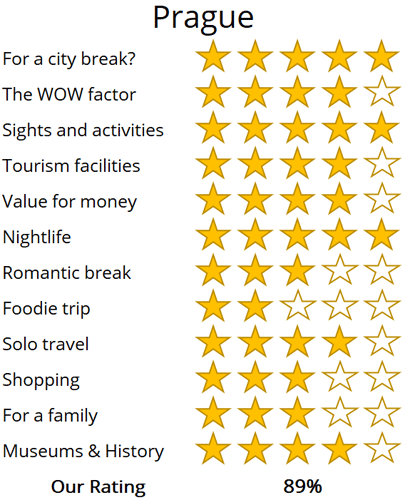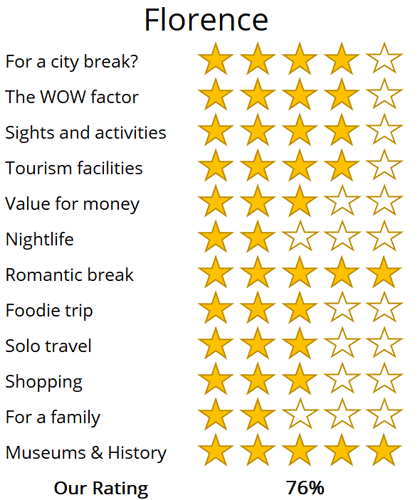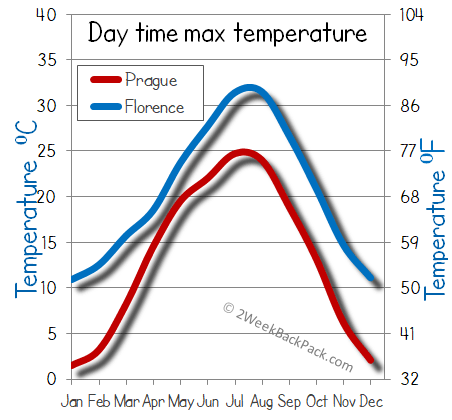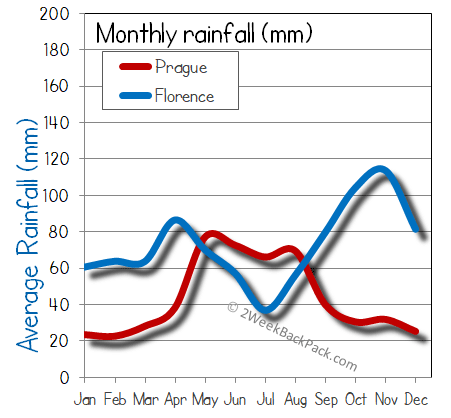WhereToGoForMyHoliday.com
The best destination comparison site!
WhereToGoForMyHoliday.com
The best destination comparison site!
Prague or Florence, which is better for your holiday in 2024?
Florence and Prague both offer unique and enticing experiences, but which one should you choose for your city break or holiday?
We recognise the difficulty in making this decision. While there is abundant information available on both destinations, clear guidance on which city better aligns with your travel preferences is often hard to find.
This article aims to provide an impartial comparison of Florence and Prague, and hopefully help you to choose the best city to visit.
The article is structured into several sections, each of which can be directly accessed through the following links:
• Introduction to the cities
• Scores and ratings
• Which one should I, friends, or family visit?
• When to visit and weather
• Who is the city suited for?
• The perfect 48hours (with map)
• Tourism details (where to stay? airport details?)
Introduction to Prague and Florence
Florence comes at you in a flurry of priceless art, pastel-painted jewellers, romantic piazzas, marble-gilded basilicas, and saffron-scented risotto. Nestled into the rolling Arezzo hills in the northern part of Tuscany, this is the very birthplace of the European Renaissance.
Florence flows in its 15th-century brilliance; there’s the Uffizi Gallery - home to works by Michelangelo and Sandro Botticelli - and the handsome Ponte Vecchio bridge.
Delve beneath the famed sights and Florence is a lived-in Italian metropolis. Locals devour lampredotto sarnies while glugging Chianti reds in hidden trattoria.
Florence’s allure is as classical as the city itself, but be warned you will be sharing the experience with many others, as there will be crowds!
Prague, the Czech capital wows visitors with its Gothic castles, cobbled lanes and handsome medieval plazas.It sits on a snaking bend in the Vltava River, unfolding with a fairy-tale Old Town district that flits from curious astronomical clocks to age-old synagogues at just the turn of a corner. Around that are other neighborhoods that beat with hipster cafes or come topped with the stunning spires of Prague Castle – one of the largest medieval fortifications in the world.
You can fill days glugging frothy beers in cosy basement bars. You can trace the footsteps of Franz Kafka in award-winning literature museums. You can delve into enchanting Christmas Markets or gaze at great monuments on Wenceslas Square. What's more, Prague sits smack bang in the heart of the beautiful region of Bohemia, a land of undulating hills and beer breweries that offers a taste of rural Europe.

The main square in Prague with the Tyn Cathedral
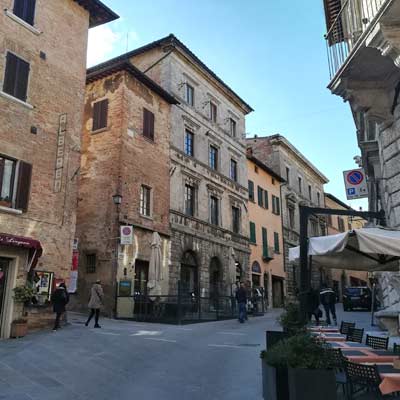
Every street in Florence is characterful
High-level summary for Prague and Florence
Summary
Where would I journey for a personal escape?
Prague
Where would I send my parents for a memorable visit?
Florence
Where's the ideal destination for my adventurous 19-year-old cousin?
Prague
Where should my food-obsessed friend indulge their culinary passions?
Florence
Note: The above comparisons are weather-independent and are based on travel during the most opportune times of the year. Details about the ideal travel seasons are elaborated upon later in this article.
In the sections that follow, you'll find a comprehensive comparison between these two fascinating cities. This includes recommendations on the duration of stay, the best times to visit, and tailored 48-hour itineraries for each city.
The final segment delves into practicalities for your travels, such as the best airport to fly into, the optimal districts for your accommodation, and insider tips, for when you come to explore the city.
We hope that you find all of this information useful, in planning your next exciting trip!
Destination details
How long to spend each city?
Prague is one of the original European city break destinations. With countless low-cost carriers whizzing in and out, it should be easy to put together a short trip here on a budget. To unearth the secrets of the Old Town, see Prague Castle, and enjoy at least a night on the beer and the goulash, a few days is probably all you'll need.
Of course, if you've got extra days, Prague will surely fill them. Excursions out to the wooded valleys of Bohemia, where the castles of Český Krumlov and Kutna Hora await, can be added into the mix. But you could also stay in the city itself, to break away from the more touristy centre into neighborhoods like hipster Žižkov and Nusle.
Florence demands at least two days. Lovers of this enchanting town will surely scoff at that. They wax lyrical about how Florence seduces folk who pass its way into staying weeks, months, years, and even whole lifetimes. Still, we think it's possible to check off the main sights, try the top dishes, and explore the historic center with around 48-72 hours total.
In the peak season there are extremely long queues for the galleries and Duomo cathedral; to avoid wasting precious time, it is advisable to pre-purchase tickets and start the day sightseeing very early (before 8am).
There are many good day trips from Florence, which are easily accessible by train, and include Siena, Lucca, and Arezzo. Florence may be a smaller city, but a fabulous one-week holiday could be had based here.

The delightful Prague Orloj is the world’s oldest operating astronomical clock, and displays the position of the Sun and Moon
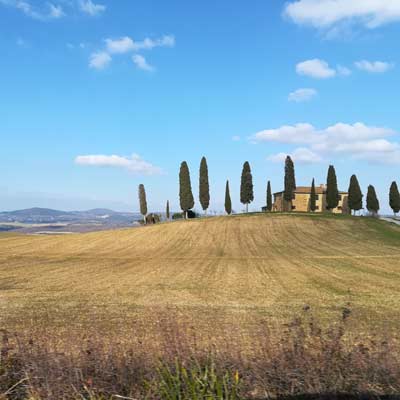
Tuscany is a beautiful region to discover
Prague has the usual four seasons of Central Europe. The summer is generally hot and humid, with the highest temperatures in the 30s during July and August. It's also common to have regular thunderstorms that last for short bursts then. Winter, meanwhile, is cold. It's the best time to visit Prague if you're in search of kitschy Christmas markets that sell blood sausages, hot chocolate and warm Czech beer. You'll certainly need the thermals and snow coat between November and March, though. It's not uncommon for temperatures to stay below zero for weeks on end.
The upshot is that the spring and autumn probably see Prague in its prime. In April, May, September and October, things can still be mild and warm. There are fewer visitors hitting the mainstay sites like the Prague Castle. Hotel rates drop considerably to boot, and you're more likely to get bargains on flights into town.
You've got to remember that Florence is up there with the most famous in Italy, and the vast majority of the 15.4 million visitors that come annually turn up in the summer months! That sends hotel rates skywards between June and August and means you'll need to jostle for space in front of Giotto's Bell Tower and the Duomo.
The ideal time to visit Florence is from April to June or September and October. They have good weather, fewer people, and cheaper prices, not to mention food festivals and wine harvest events. Winters are cooler and possibly wet but have the lowest number of tourists.
Culture and art are the pillars of Florence. Lovers of the late Middle Ages and the Renaissance will feel right at home between the Accademia Gallery and the Uffizi. Within their halls are iconic sculptures like Michelangelo's David, The Birth of Venus by Botticelli, and Caravaggio's haunting Medusa. And that's only scratching the surface!
Adding to the mix are the intriguing collections of the Museo Galileo for science buffs, the Ponte Vecchio for architecture aficionados, and tasty Tuscan farm foods for gourmands. Downsides include high visitor numbers, so it's best to steer clear if you're not a fan of crowds, particularly in the summer.
Florence is not an overly expensive destination, is relatively safe and has a small city atmosphere.
Prague is a heritage-rich, historic and hedonistic European city. You'll spend your time gawping at haunting castles and getting lost in medieval districts. Of course, there's also plenty of room for evenings of Czech beer and samplings of Slavic dumplings and goulash. If you're a food-loving culture vulture then there's hardly anywhere better on offer. What's more, backpackers and partygoers will find loads to like in the sleepless basement bars and pubs.
What Prague can't excel in is proximity to the ocean. If you're looking for somewhere to dine on seafood and hit the beach, it's not the place for you. The same goes for the great outdoors. It isn't hard to escape to backcountry Bohemia from here, but you will need to rent a car or organise a day trip away from the Old Town to do that.

The Charles Bridge spans the Vltava River in central Prague and is lined the thirty Baroque statues
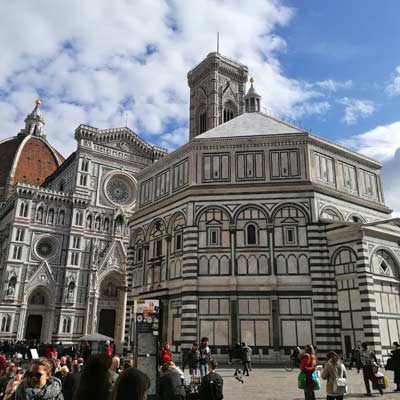
The Duomo has a gothic design, but the façade is covered in red green and white marble
48hours in Prague
Spending two days in Prague allows for a perfect balance between exploring its historical wonders and delving into its vibrant urban life. The enchanting Old Town and the imposing Prague Castle splendidly represent the city's rich history, while trendy districts such as Žižkov offer opportunities to enjoy coffee and scour through the markets.
Day 1: Start your weekend right in the heart of the city at the expansive Old Town Square, the central hub of Prague's historic quarter. It remains lively throughout the year, bustling with visitors meandering between significant landmarks such as the Old Town Hall and the Church of Our Lady before Týn. Notably, the church is renowned for its striking black Gothic turrets, towering over 80 metres tall.
Meanwhile, the Old Town Hall boasts stunning Gothic doors and gargoyles, and is home to the unique Prague Astronomical Clock. This 15th-century timepiece is the oldest functioning astronomical clock worldwide, drawing crowds every hour to witness its charming chime and the procession of apostles.
Continue east through the Old Town's intricate alleyways until you reach the riverside, leading directly to the iconic Charles Bridge. Adorned with statues of saints, it offers picturesque scenes, especially in the misty winter mornings. Cross over to Malá Strana, Prague’s oldest district, filled with traditional beer taverns such as the popular U Hrocha.
After a refreshing beer, it's time to ascend to Prague Castle, conveniently located steps away from the tavern. Dedicate your afternoon to exploring this vast complex, ranging from the magnificent St. Vitus Cathedral to the quaint workshops of Golden Lane.

The Dancing House may be one of Prague’s most distinctive buildings, but being in the heart of the old town its unique design was extremely controversial
Day 2: Treat yourself to a hearty breakfast in boho Žižkavárna Café. It's loved by the locals for its strong coffees and homemade cakes but is also a fantastic intro to the stylish neighborhood of Žižkov itself. The landmark at the heart of that district of the soaring Žižkov Television Tower in Tower Park Praha. Be sure to take in its futuristic architecture from below before going inside. Then, it's straight up to the observation decks to enjoy sweeping views of the city.
You'll also want to drop by the National Memorial on Vítkov Hill. It's an important spot in the annals of Czech history. It was once a hops plantation but now hosts the colossal equestrian statue of Jan Žižka (a revered Czech military general) and the Tomb of the Unknown Soldier, a symbolic monument to resistance to Nazi occupation.
Keep going north across the river to Prague 7 and you'll find stripped-down hipster cafés like Kavárna Liberál. For dinner, try the multi-ethnic stalls of Hala 22 closer to the waterside, where everything from Rajasthani curry houses to Chinese noodles are options. Finally, get your beer drinking hat on, because Gyllene tigern – a legendary microbrewery – beckons with its hoppy unpasteurized tipples back in the Old Town.

The Klaus synagogue and cemetery, in the Jewish quarter of Prague
48 hours in Florence
Early morningstarts are key in Florence, to hit the galleries and basilicas before the crowds. Don't worry, though, this two-day itinerary has time to rest with beautiful views in Renaissance gardens come the afternoon…
Day 1: Make for the Piazza del Duomo for the break of dawn – seriously, the earlier you can get there the better. That way, you can snap shots of the great cathedral and adjacent Giotto's Bell Tower without plumes of visitors getting in the way!
Look to the green-white marble inlays and the striking Gothic Revivalism of the whole building and think about hitting the 87-meter high lookouts of the belfry for some sweeping views across the city and the Apennines.
Traditional Tuscan design oozes from the lovely Palazzo Vecchio on Piazza della Signoria – this is the town hall, dating from way back in the 1400s. Grab an on-the-go pizza slice and make north to Galleria dell'Accademia after that.
A quick in and out there should be enough to appreciate the wonderful David statue by Michelangelo, before hopping back to the riverside and crossing the Ponte alle Grazie (have the camera ready).
For sunset, a climb to the Piazzale Michelangelo is a must. The panoramas include the Tuscan hills and the pastel-painted tops of the city, which look stunning as the light dips low.
For dinner try the regional meal of Bistecca alla Fiorentina (Florentine steak).

The shops along the Ponte Vecchio traditionally sold jewellery
Day 2: It's a museum morning in the famous Uffizi Gallery on day two. For art lovers, the journey here is a rite of passage. The collections span several wings of a great palace in the heart of central Florence and can take hours on end to appreciate fully.
Highlights that simply can't be missed include The Birth of Venus (Botticelli), Laocoön and his Sons (Bandinelli), Raphael's portrait of Pope Leo X, and Caravaggio's unforgettable Medusa. Back outside, the Ponte Vecchio bridge isn't far. It was once a butcher's market but is now famous for its jewellery boutiques.
On the hills beyond are the handsome Boboli Gardens, all brimming with babbling fountains and carved statues. Further up again is Forte di Belvedere, where even more breathtaking views of Florence are on offer come the evening.
Related articles: Florence in 2 days

The Uffizi Gallery exhibits the greatest collection of Renaissance art

The statue of David is regarded Michelangelo finest work
Florence
The best place to touchdown on a flight is surely Amerigo Vespucci International Airport. A mere 15 minutes' drive (7km) in a taxi, or 30 minutes in a train, can link you from the downtown to the terminals there.
Unfortunately, the bulk of Europe's budget carriers will jet into Pisa. That's still close – around 1-1.5 hours (83km) in the bus to the west.
Avoid flying into Bologna, as this is even further away (115km), and bus transfer 1.5-2 hours.
You definitely won't have to worry about finding somewhere to stay. From slick boutique hotels to simple hostels, Florence has all sorts. The town's primary industry is tourism, after all. Just expect prices to soar in the middle of the summer, before dropping again around the start of September.

The Piazza della Signoria
In terms of neighborhoods, you'll want to focus on bedding down within the SS67 ring road. More specifically, the districts of San Giovanni (the historic core) and Santa Croce are perhaps the most central, even if the latter retains a lived-in Italian feel. San Marco is a whisker to the north, hosting the bulk of the low-cost hotels and guest houses. Oltrarno boasts buzzy nightlife venues and hip coffee shops.
Related articles: Where to stay in Florence?
You probably won't need any forms of transport in Florence other than your own two feet. The town is eminently walkable. Be sure to bring comfy shoes that are suited to long days, however, especially if you're keen to scale to the lookout points around Piazzale Michelangelo.
For exploring the surrounding region, a rental car is a must. These tend to be cheap in Italy and are best organised from the airport to avoid driving through the centre of town.
Aside from the infamous Stendhal syndrome – a condition supposedly caused by exposure to too much beautiful Florentine art – there are no standout risks to visiting this city. The centre is generally safe and well maintained, crime rates are relatively low, and the locals are often happy to help out.
The Václav Havel Airport Prague is the main entry point to the Czech capital. It's also the largest international airport in the Czech Republic. That means short-haul flight connections arrive there from all over, and you can usually bag some wallet-friendly bargains on carriers like Ryanair and EasyJet
For a European capital, Prague is very walkable and bikeable. The whole Old Town is actually best explored on foot, and the same goes for the castle district. For longer trips, the uber-efficient Prague Metro and tram network combine on the PID ticket to offer easy hops from A to B.
The basic ticket costs 24 CZK ($1) and allows access and transfers for 30 minutes. Buy them via the Prague transport mobile app, in local newsagents, or at the tram stops themselves. Don't forget to validate your ticket at the yellow machines on board.

The Gothic Saint Vitus Cathedral lies within the Prague castle complex
All the usual crimes and scams of a European capital are present in Prague, though the town is generally very safe for visitors. Be vigilant of pick pocketers in busy areas and on public transport especially. Also try to dodge picking up taxis straight off the street – tourists are often prime targets for inflated rates. Prague's currency exchange points are notorious for being rip offs, so get your koruna before touching down.
For proximity to the main sites and bars, there's really nowhere better to bed down than in the Prague Old Town. Hotels will usually cost the most there, however. Something quieter and equally as atmospheric is available in the Malá Strana. But the New Town district and Žižkov are also both good options.
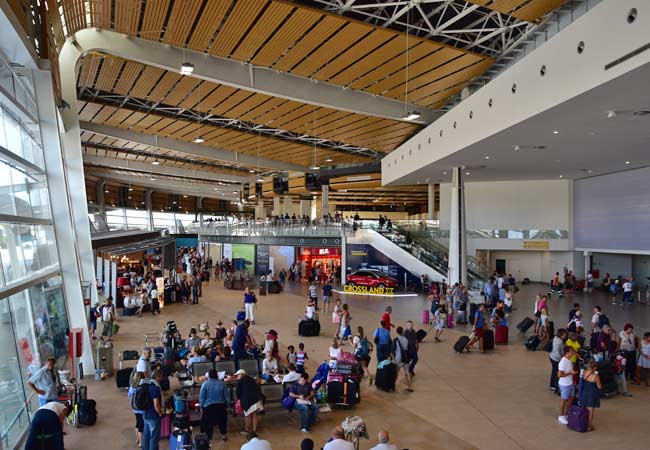
oh we were stuck in the airport!

Copenhagen was a bit expensive...

All we did was drink beer in Brussels...
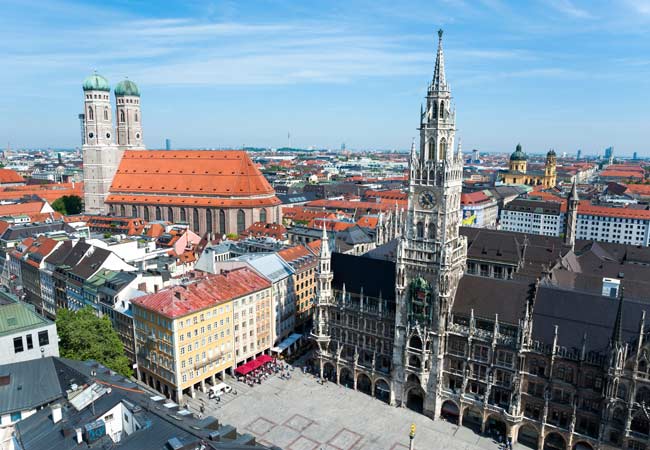
Muncih was crazy
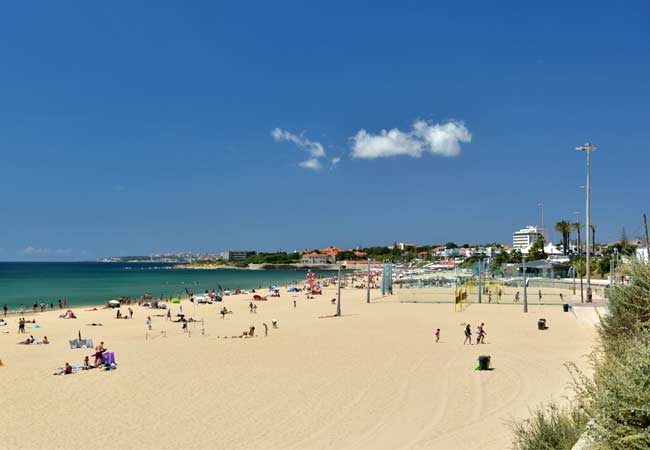
And we got so burnt!
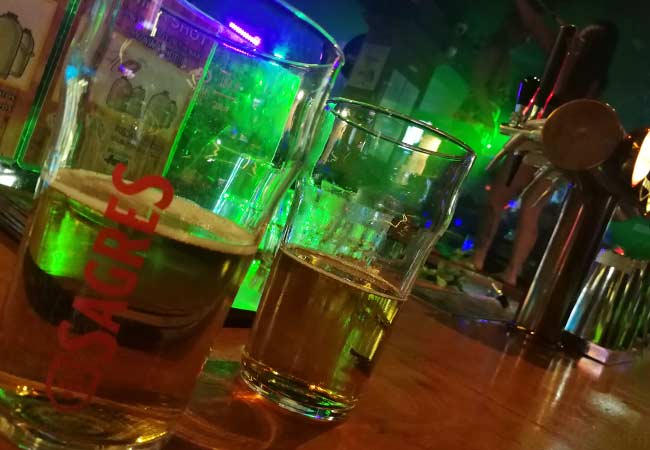
Remeber that night in Rome

oh we were stuck in the airport
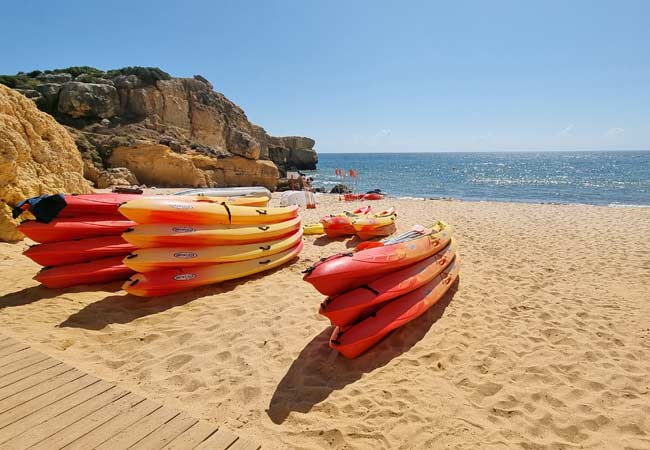
So much fun kayaking

Berlin and that group from Austria!

There was such a view from that church

And we got so burnt!

Munich was eventful, wasn't it!

Such a view from that cathedral in Florence
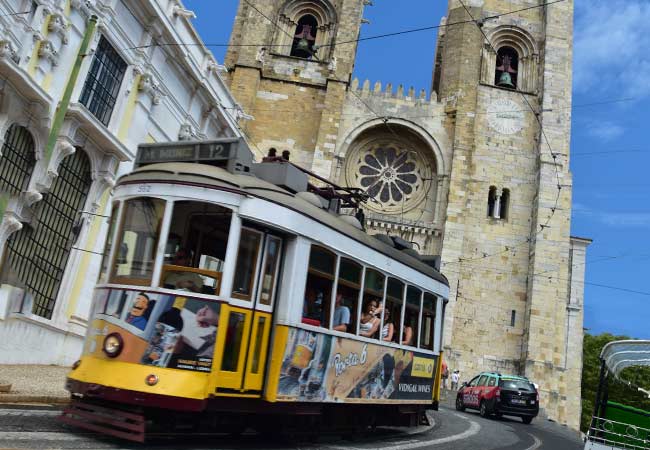
Lisbon was such so much fun

Last summer was so much fun .... x

Remeber that night in Rome

Lisbon was such so much fun

Such a view from that cathedral in Florence

Munich was eventful, wasn't it!

And we got so burnt!

Remeber that night in Rome

All we did was drink beer in Brussels...

Berlin and that group from Austria!

Can't wait to go back to Dubrovnik

Remember that boat ride in Prague

Copenhagen was a bit expensive...
